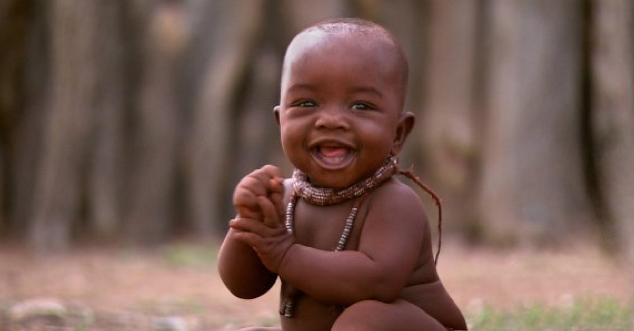
While Grandma was visiting, Sam and I went on a date (squeal!). A real, live date, to a movie theater. With greasy popcorn, and hand holding.
On that date, we saw Iron Man 2. (Good popcorn movie, no?)
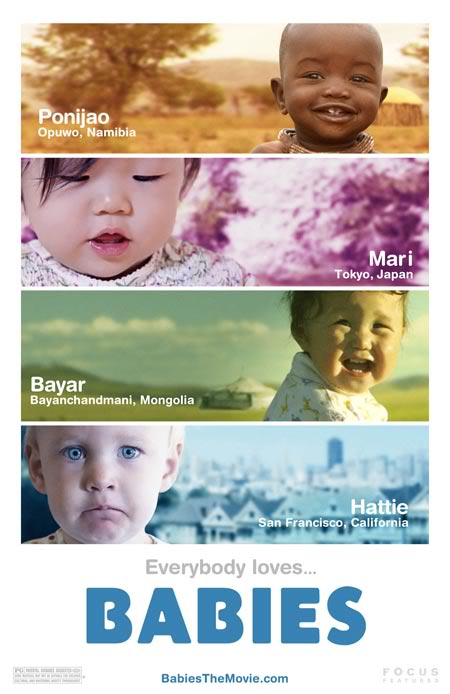 But a few days later, while Mikko was in school, we went all-out extravagant and saw a second movie in a theater: Babies. We got popcorn again (hey, movies are a rare treat since a certain little event almost three years ago called Giving Birth to a Squaller) with Kernel Season's white cheddar topping
But a few days later, while Mikko was in school, we went all-out extravagant and saw a second movie in a theater: Babies. We got popcorn again (hey, movies are a rare treat since a certain little event almost three years ago called Giving Birth to a Squaller) with Kernel Season's white cheddar toppingI had been looking forward to this movie since first hearing teasers about it on various crunchy blogs. We put the release date on the calendar so we wouldn't forget to catch it when it came out. And then I waited, and waited.
Ah, but it was worth it!

The filmmaker, Thomas Balmès, follows a baby each from Mongolia, the United States, Japan, and Namibia. Here's the trailer so you get the idea:
I purposely have avoided reading any interviews or other film reviews before getting my thoughts down. If necessary, I'll come back to do a follow-up later, but for now, these are my reactions.
I thought the film was beautiful and reflective. It's not a very long movie, and there aren't any subtitles to get in the way of just observing. You feel like something of an anthropologist as you watch the lives unfolding on the screen and compare what's happening to the other scenarios and to your own experiences and culture.
Ponijao, Namibia:
I really liked seeing how closely knit the Namibian community was. The baby there lived in the desert within some sort of tribe of herders, and they sat around most of the day,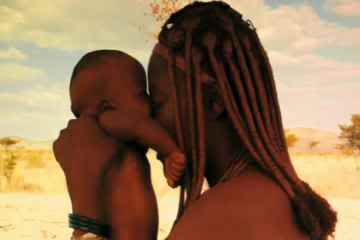 breastfeeding, doing each other's hair (loved! their! hair!), making jewelry, and talking. In some ways, it seemed boring; in others, idyllic. It certainly was a lot less frenetic than the Tokyo and San Francisco scenes!
breastfeeding, doing each other's hair (loved! their! hair!), making jewelry, and talking. In some ways, it seemed boring; in others, idyllic. It certainly was a lot less frenetic than the Tokyo and San Francisco scenes!There were a ton of flies, and this setting and the Mongolian one made Sam's mom remark later, "Well, that proves dirt doesn't kill babies." The flies notwithstanding, I was really taken with how much of their lives the Namibian babies (because there was always more than one around, even though Ponijao was the "star") spent outdoors and interacting with nature. They played with stones and sticks and running water, because — that's all there was! It was both refreshing and, you know, not something I'd choose for myself.
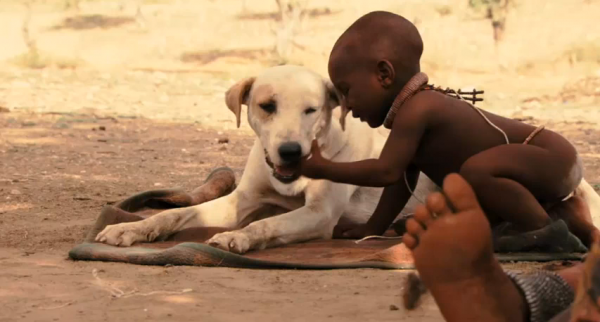
I loved seeing real-world elimination communication in action, even though the theater's response to the baby pooping on her mother's leg was a collective "ew." The babies wore no diapers, and the mother purposely wiped the baby's bum on her leg, then whisked her leg clean(ish) with a sort of stick brush. No BBLPs
I also lurved the breastfeeding depictions, which included scenes of tandem feeding. The women were topless (one reason for the PG rating), so the breastfeeding was matter of fact and frequent. I loved watching the mother trying to latch the newborn on while simultaneously getting her toddler's attention to keep suckling, all the while trying to shake her luxurious locks back out of their way. I also liked the scene where she was feeding her daughter and another baby toddled up, presumably to jockey for some nummies, too, and the mother sort of gently told the other baby off. There were no subtitles, but I like to think she was pointing the other one in the direction of the baby's own mother for a snack.
We didn't see much of the fathers, but I did enjoy seeing some of the older kids, boys and girls, who were entirely comfortable around the babies and the mothers. I love to think Mikko will one day be as easygoing and nurturing around babies as some of the adolescent Namibian boys. I think this is one of the ideals espoused in The Continuum Concept,
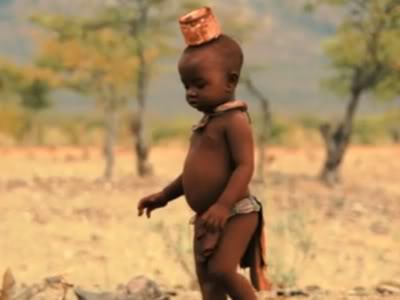 afford babies their rightful place within a society (giving them the attention, breastfeeding, cosleeping, babywearing, etc., they need), the other tiers of the society also find their rightful place. Jean Liedloff's contention was that a lot of the strain between different ages is a resentment over how we were (mal)treated as infants and a constant seeking to reestablish what we missed out on. Not to defend the psychology of that, but I did love seeing this loving tribal atmosphere in action, where all the members seemed content (at least from the outside) in their particular life stage, rather than jockeying to be treated as younger or older, and therefore seeing those older or younger as a threat, as seems to happen a lot in our society.
afford babies their rightful place within a society (giving them the attention, breastfeeding, cosleeping, babywearing, etc., they need), the other tiers of the society also find their rightful place. Jean Liedloff's contention was that a lot of the strain between different ages is a resentment over how we were (mal)treated as infants and a constant seeking to reestablish what we missed out on. Not to defend the psychology of that, but I did love seeing this loving tribal atmosphere in action, where all the members seemed content (at least from the outside) in their particular life stage, rather than jockeying to be treated as younger or older, and therefore seeing those older or younger as a threat, as seems to happen a lot in our society.Away from philosophy again, I also loved witnessing the heavy-duty babywearing. Ponijao's mother did things with her strapped to her back that I would have considered either too strenuous on me or too jolting for the baby — but she fell right asleep! Loved that.
Mari, Japan:
 I found comparisons between Japanese and U.S. culture one of the most fascinating aspects of Our Babies, Ourselves,
I found comparisons between Japanese and U.S. culture one of the most fascinating aspects of Our Babies, Ourselves,One thing that struck me about the Japanese experience was the peacefulness of the birth, not unlike the Namibian birth. Not much detail is shown, but it set the tone for the whole Japanese set of being relatively quiet and serene, even in the bustling metropolis of Tokyo.
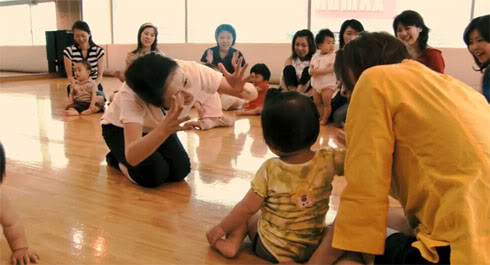 Although Mari was the couple's first child, I also noticed that the mother was much less alone than in the U.S. scenes. I know it's easy for mothers in the U.S. to feel isolated, but Mari's mother seemed either to intentionally seek out other mothers and groups to belong to, or it just happened naturally within her culture.
Although Mari was the couple's first child, I also noticed that the mother was much less alone than in the U.S. scenes. I know it's easy for mothers in the U.S. to feel isolated, but Mari's mother seemed either to intentionally seek out other mothers and groups to belong to, or it just happened naturally within her culture.Mari was also breastfed and worn a lot, which was lovely, and she coslept in a great big fluffy bed, belying American fears of combining duvets and infants.
I also loved the touches in the film like the recurring kitty cats interacting with the kids. I couldn't believe the patience of some of the film's animals!

Hattie, USA:
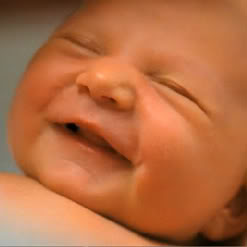 It's harder for me to evaluate the U.S. setting objectively. For one thing, I kept comparing myself to Hattie's parents and thinking, Well, I would do that differently; oh, I would do that the same; I think that's relatively crunchy for American culture, but this is San Francisco; oh, it's a shame they felt coerced into that. And so on.
It's harder for me to evaluate the U.S. setting objectively. For one thing, I kept comparing myself to Hattie's parents and thinking, Well, I would do that differently; oh, I would do that the same; I think that's relatively crunchy for American culture, but this is San Francisco; oh, it's a shame they felt coerced into that. And so on.Seeing the filmmaker choose one family and one child to represent the whole USA (and, really, the whole of "Western" culture) made me realize how much weight is put onto that one tiny baby's shoulders. It's easier for me to objectify people from other cultures and assume they faithfully represent their culture as a whole. When you're familiar with (and part of) the culture, you're much more likely to quibble with the person they chose to represent you. (It reminds me of Paul Reiser's standup joke where he imagines the Neanderthals groaning that the archeologists are basing all their perspective on Neanderthals on Howie, the only one of them with the sloping forehead and a unibrow but who was conveniently nearer the surface.)
Another reason it's hard to be objective about the U.S. family is that it's hard in general to summarize your culture when you live within it. So much is taken for granted and goes
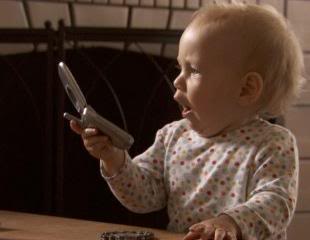 unnoticed. Just to give an example, when I was choosing pictures to go with this post, I scrolled through pages of film stills and selected my favorites, then realized: I had no pictures of Hattie, the USA child. Had their been no options with her? I scrolled back through the stills. No, there she was, in several. They were just so boring to me that I'd passed them by. Yeah, yeah, a white baby in Western clothes holding a cell phone or taking a shower with indoor plumbing — big deal.
unnoticed. Just to give an example, when I was choosing pictures to go with this post, I scrolled through pages of film stills and selected my favorites, then realized: I had no pictures of Hattie, the USA child. Had their been no options with her? I scrolled back through the stills. No, there she was, in several. They were just so boring to me that I'd passed them by. Yeah, yeah, a white baby in Western clothes holding a cell phone or taking a shower with indoor plumbing — big deal.That said, there were some things I did notice, considering my parenting bent. First of all, the birth was medicalized. Of course. There was some breastfeeding and cosleeping and babywearing, though, which was cool.
But what struck me most of all, by comparison with the other families, and what rings true to me as an American mother, was the loneliness. You barely ever saw Hattie with anyone but her parents, and you rarely saw the parents with anyone else. Sometimes, yes, but not often.
I also noted that the U.S. family seemed to have the most shots with the father, which in retrospect I think is interesting. I could definitely see that there's been a Western trend toward fathers being more involved with their kids. Again, this is not something that stood out to me as I watched, because my own experience reflects the reality that the father (in my case, Sam) is deeply involved as a parent. But, looking back over the other scenarios, I realize that's a little unusual, and from where I'm standing, a bonus point for the good ol' U.S. of A. Since I like to blast us for pretty much everything else mainstream we do.
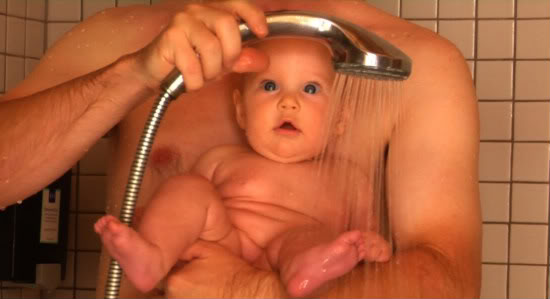
In contrast, for instance, there were certainly cringe-worthy moments when I imagined the Namibian and Mongolian families standing over my shoulder (this is just fantasy, mind you) and gawking at our insistence on bringing our babies to special music classes where we sing sappy songs from someone else's culture (American Indian, in Hattie's case), or the fact that we can afford our own private hot tubs, not to mention the clean water going into them and the electricity powering them and the repercussions all that has on the environment of the rest of the world. But, you know, American culture is what it is. I thought Hattie's family was a pretty good representation of some of the highs and the lows that encompass parenting in the USA.
Bayar, Mongolia:
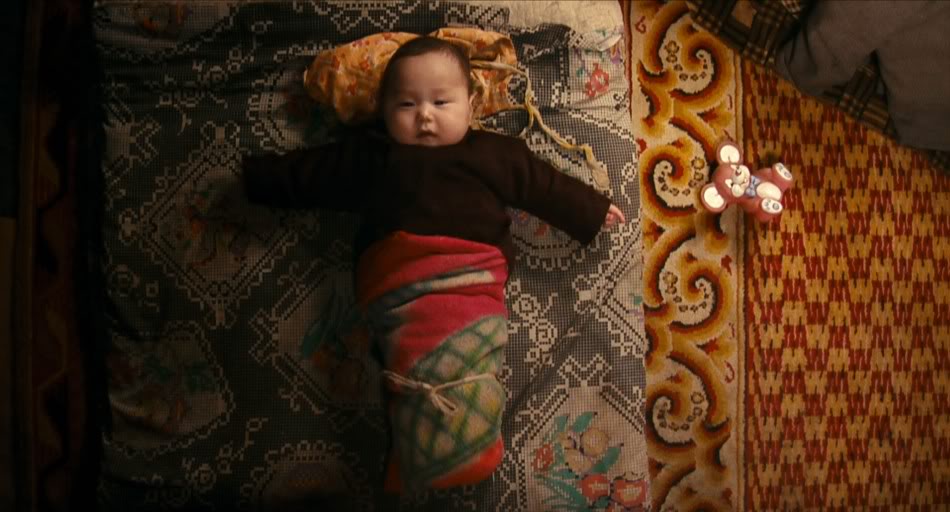
The Mongolian family was the saddest to me. I don't know if they consider themselves sad, but Bayar just seemed so isolated, not just from other families (they were also some sort of herders, but apparently as a nuclear family, not as a tribe) but from his own mother. The birth, even more than the American one, was harsh and medicalized, and the baby was immediately swaddled and laid apart from his mother. It was actually quite a tear-jerking scene for me as the camera filmed the baby in his clear bassinet with the mother staring at him blankly and exhaustedly from her hospital bed.
Bayar stayed swaddled until he could crawl, which I don't have a problem with in theory. But they would then just leave him lying around, rather than carry him with them. Once he was mobile, they tied him to a table leg to keep him from wandering far. It was just kind of … sad.
Bayar's older brother, maybe two years old or so, was clearly incensed at his displacement, and he took his anger out on Bayar, with pretty much no intervention from any adults (including whoever was filming).
When you did see Bayar with his mother, it was often a tense scene: washing his face with breastmilk while he screamed, being spanked repeatedly for tipping over a bucket of dirty water that he and his brother were playing with when he was all of around 8 months old (I'm guessing).
I couldn't help thinking: This is the culture that bred Genghis Khan.
Which I know is absurd. Americans are notoriously bellicose, as are Westerners in general, as are (or have been) the Japanese. I don't know much about Namibia (sorry! — OK, here's a start), but Africa overall is not a model for peace. So, I don't know — is our culture changing for the better as we become more interactive and less hostile toward our children? Or does it not matter, as with places in Africa that still ascribe to tribal ideals but have heavy conflict? (But there are a whole host of factors there that have nothing to do with child-raising techniques, like colonialism and poverty and on and on, so maybe it's too complex to make a comparison.) I'd like to believe treating our youngest and most vulnerable with respect and reverence results in good things as that generation grows up. I feel kind of pessimistic for Bayar's chances of having a fulfilling relationship with his future children, or even a secure attachment to his own family.
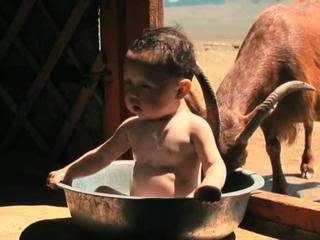 I don't know! Anyway, what I liked about the Mongolian family was, once again, seeing elimination communication as it's practiced traditionally. When he was very young, they placed a puddle pad under him and let him pee on it as he needed to. As he got older, he just pretty much never wore pants, and he wandered around the yard at will, playing with (i.e., manhandling) the goats and exploring on his own. It looked a little lonely, a whole lot free, sometimes scary, and kind of fun.
I don't know! Anyway, what I liked about the Mongolian family was, once again, seeing elimination communication as it's practiced traditionally. When he was very young, they placed a puddle pad under him and let him pee on it as he needed to. As he got older, he just pretty much never wore pants, and he wandered around the yard at will, playing with (i.e., manhandling) the goats and exploring on his own. It looked a little lonely, a whole lot free, sometimes scary, and kind of fun.Conclusions
I wasn't sure if Thomas Balmès had a specific agenda when filming the movie and was trying to craft a message, or if he really just wanted to present some observations. I know you can't create art in a vacuum, and all documentaries are influenced by the documentarian. Specifically with Babies, I wondered how much of the silence and the non-intervention by adults was requested or demanded, and how much was instinctual or culturally based.As I said, there were no subtitles, but there wasn't any need for them because there was overall very little talking at all. In fact, there were many, many scenes with no adults present on-screen.
As I mentioned, the Mongolian baby kept being mauled by his toddler brother without any adult stepping in to stop the abuse, and later that same baby aggravated a playmate with no one intervening. In the U.S. family, the baby was eating a banana in one scene that had a hard piece that she popped in her mouth but then had trouble chewing and spit back out. The father was sitting at the table with her, because he handed her the banana and received the spitted-out piece from her in his palm, but he didn't reach out in the first place to take away the hard piece before she could put it in her mouth. I don't know about Mongolian culture (though clearly I've drawn conclusions), but in U.S. culture, I think most parents would have intervened before she put the clearly dangerous and inedible portion in her mouth.
I thought the same as I saw the babies take their first wobbling steps and wondered at how hands-off all the parents were about it. Again, I would expect more helping behavior from the U.S. parents, which makes me wonder if all the adults were coached to stay out of the babies' way.
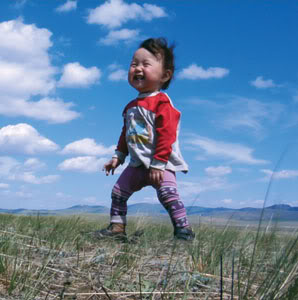 In the end, I thought Babies was a fun film treat, an observational look into four different cultures. It didn't seem to draw any conclusions for me, but it gave me plenty to think about. It's the kind of movie that would make a good springboard to studying more about the cultures seen, or any of the behaviors that seemed odd.
In the end, I thought Babies was a fun film treat, an observational look into four different cultures. It didn't seem to draw any conclusions for me, but it gave me plenty to think about. It's the kind of movie that would make a good springboard to studying more about the cultures seen, or any of the behaviors that seemed odd.And, most telling, there was a little girl in the theater with us who was maybe 5 years old. She sat through the whole film with only a few politely voiced questions to her mother. I thought that was pretty impressive — both for the girl, and for the power of the movie to draw you into four babies' lives.
If you can find a convenient babysitter for your own hot date night (to see a documentary! on babies!), you might also be able to score free tickets, fyi. I've seen several giveaways of movie cash for Babies posted on various giveaway blogs, so run a search to find some if you're poor but still want to attend! Here are a few to get you started:
Some of them end rather shortly, so click over and enter posthaste if you're interested and desperate.
(P.S. I'm not in any way being compensated [or solicited] for promoting these giveaways, and I paid for my own tickets [and my mother-in-law's!] fair and square. This is out of the goodness of my kind little heart to get you into a movie for free without resorting to sneaking past the ticket booth. But if all else fails and you need me to create a distraction for you, call me up. Enjoy!)

Did you see Babies the movie? Whaddja think?









 I'm Lauren Wayne, writer and natural parent. I embrace attached parenting with an emphasis toward green living.
I'm Lauren Wayne, writer and natural parent. I embrace attached parenting with an emphasis toward green living. 


26 comments:
I wanted to see this movie so badly the Saturday before Mother's Day, when I went on a hot date with my hubby. But...he wasn't interested. (You'd think I would have had the choice, considering it was my Mother's Day date!!!) Maybe I'll get to see it eventually! I liked your review though, even without having seen the film!
I saw the movie, Babies, and I loved it. I just wanted to point out that the US baby was actually born at home and only transferred to the hospital because she was having breathing issues. Filming of that family started in the hospital and that's why we didn't see the homebirth.
I really enjoyed your write-up on this since I don't know if I will get to see it. Now maybe I'll have to go hunt it down!
THANK YOU for this write-up, Lauren! I want to see this movie so badly, but there were only two theaters in our ENTIRE STATE showing it, so I'll have to wait for DVD.
Anyway, what you said about the Mongolian family was frankly shocking to me considering what I had read before about Mongolian approaches to parenting at Peaceful Parenting last summer (and that article has been removed - apparently it was a Mothering reprint?). Anyway, it seemed to show Mongolian families as being very interactive and very attached. I have to wonder if this is a case where, like the USA family, they represent SOME Mongolian aspects but not all? Hmmmm. Anyway, that stood out to me.
Again, I so appreciate your viewpoint on it and I know I will be equally delighted to see different aspects of AP and non-AP approaches as they play out across the globe.
Sounds fascinating. Interesting that you felt that the US family was not particularly representative of mainstream US parenting; the families from the other countries could similarly have been unrepresentative of their cultures. The Mongolian upbringing sounds a bit weird, especially the bit about tying the baby to a chair leg.
Not heard of this film before but I will definitely look out for it.
PS I love Our Babies, Ourselves as well.
Mallory: Poor you. :) Hope you can find someone else to go with — maybe a mothers-and-babies showing?
Navelgazingbajan: That explains it, because I did get the sense of NICU, etc. But, yeah, the scene focused on the drips and lines and whatever attached to the baby, and the sad little prickmarks on her skin. So, as a home-birthing family, again they're not overly representative of the American norm.
The Grumbles: Good luck!
Megan: Two in the state?? Bummer! We did end up seeing it at a tiny independent theater, but it was a nice touch. And I totally forgot about that Mongolian article, which I lurved. I read it originally in Mothering magazine, and you're right — it was all about how breastfeeding was considered the norm, and everyone was being all supportive about babies. So, yeah, maybe either (a) this mother was coached not to interfere and to step out of the frame a lot or (b) she has her own issues. I don't know, too, if Mongolian city life is a lot different from herders' lives. They seemed pretty geographically isolated. There was one nice scene with the whole (extended) family celebrating something, but mostly we were shown Bayar alone or with his brother.
Cave Mother: Very good point! In some ways, I thought the tying to a chair leg was, as I said, sad, and in some ways, I realized maybe it was just like our use of playpens and bouncy seats and the like. I can still consider those sad sometimes, especially when they're overused, but they do let a mother do something without worrying too much about where the child has crawled off to. He actually manages to make quite a mess even tied up, which was humorous, and later he's allowed to roam free as a toddler. So maybe that scene was like showing the one time a U.S./U.K. mother resorts to a playpen so she can take a shower, but since it's on film it looks like This Is What Usually Happens. I think I will read some interviews with the filmmaker now, to hear his perspective.
Oh, also: I've been wondering if it would have been better or worse had he chosen a very mainstream Western family. In some ways, it could have made the comparisons with the other cultures sharper. But maybe something would have been lost, too, in making it seem like a message of right vs. wrong ways of parenting. I'm wondering if maybe the film was trying to show four "natural" ways of bringing up babies, but in four distinct cultures.
In addition, I almost thought maybe it was a good message to show how a Western family can be (fairly) natural. Lots of skin-to-skin contact, respectful treatment of their child, going outdoors, riding bikes, etc. Some things made me laugh, like when Hattie hits her mother and the mother says something like, "Oo. Hm," and then reaches behind her from the bookshelf and pulls out a book called No Hitting and asks if they need to read this. It's one of those good-but-cringey moments to me. Like, it's so peaceful, and at the same time, of course Westerners have a book on the subject.
All right, I'll go read some articles about the film and then come back. :)
I have been curious about this movie... thanks for the review.
I haven't seen this movie, but I would like to. Until then, I've found your thoughts intriguing. Thanks for sharing them!
I went to Namibia in 1996 and the women there *were* indeed beautiful. I'd love to see this movie just even to see a little bit of that gorgeous country again.
I was going to point out the same thing about the Mongolia article. Interesting!
Didn't have any interest in seeing the movie, but now I do. Great review!
I really want to see this. I love babies, and I love peeking into other cultures. I believe there is value in every culture that we can learn from (I love Our Babies, Ourselves, too).
That's interesting that the US mom had a home birth, since that's not typical here. It's too bad they didn't show that part, though. Maybe I'll post a review after I've seen it, too. :)
My wife just sent me a link to your blog here and I am looking forward to reading through it. I had seen "Babies" advertised and we are looking forward to seeing it!
We have five kids that we homeschool and as I (the father) work from home and Mama works out of the home three days a week, I get to be very involved with our kids which I love and would not trade for anything. Actually, I quit a very secure, good paying I.T. government job to be with my kids and wife :) Absolutely NO regrets!
Wow, I have been wanting to see this movie since I saw the trailer months ago. Thanks so much for the informative review and free ticket giveaway links.
I might just be able to see it. ;)
There are such a great many things I could say now, but I ave a dinner party coming up in 5 mins,
let's say this very quickly
* dads in Africa are more implicated in the childrens life than western dads, at least in ubanised africa and the masaai (which I think they were) are an extreme example of african society
* Dani Arnold (informed parenting) has a great article on primal parenting about pygmees in Congo and violence
I think I'll read this again slowly if ever I get the time and write some posts about this
I just posted about this movie myself! Only that I hope I get to see it as in Australia it's on a limited release. I may have to wait for the dvd. Thanks for the great review!
In an interview with Thomas Balmès, he was asked which culture he would most like to raise his child in and he chose Mongolia. I can't remember all of the reasons, but one of them was the freedom the children there have to wander in nature. Interesting that you felt that the Mongolian boy's life was sad. I haven't seen the movie so can't comment myself, but thought it was interesting that Thomas Balmès should have such a different view. I wonder what he saw that the movie might not show.
I am so excited to see this movie! I already have a date night swap planned with some good friends of ours :)
Was your review in the same order as the movie? The Mongolian scenes sound like tear-jerkers for me as well and I literally found myself covering my mouth in shock as I read your words. I'm hoping that the movie doesn't end on those sad notes because I'd rather walk out happy than depressed, ya know?
Melodie: So true!
Lisa C: I'd love to read your thoughts after you've seen it!
Steven C: It is great that both parents have options like that, isn't it? It sometimes requires counter-cultural thinking and creative planning, but it's so worth it. Sam & I both work from home and have intentionally arranged our lives that way so we can be involved together as a family all day. Love it! Was checking out your blog and am mighty jealous of your sailing adventures. We have a dream to one day live aboard a houseboat. :)
mamapoekie: Will have to check out the Dani Arnold article if I can find it — thanks! The dads not being involved in the Namibian scene might have been a consequence of the filmmaker's choices or editing, I don't know. I saw plenty of family life in general, which led me to believe there was inter-generational and cross-gender involvement. I don't know enough about Namibian tribal life (or this one in particular) to say what its structure is like. I was going off only the observations I made from the film.
fjkelly: See, that makes me wonder if I just had an unlikely emotional reaction to the Mongolian scenes. Or maybe he values things differently as a non-mother. I saw the baby lying alone with a rooster crawling near him and thought, How lonely, and maybe Balmès framed the same scene thinking, How free. I'd like to see a how-it-was-made feature or behind the scenes clips, because I bet they'd show more of the parents' reactions, which were often missing in the final film.
jorjedatoy: No, the settings were all interspersed, which I found appealing. It was more arranged chronologically and then somewhat thematically. I thought of writing my review along the same lines but found myself separating it out into places in my mind. I don't think you'll be depressed walking out, and frankly I'd be really interested to hear yours and anyone else's reactions to the movie, because now I'm doubting some of my observations and conclusions. :)
I saw it. I wasn't really sure what we were going to see (I had suggested Letters to Julia and the other girls wrote back they wanted to see Babies. I didn't really care... I just love going to the movies). I was amazed at the differences.
I agree with Cave Woman, though. I wonder what it would have been like to have a more mainstream western family. Although, the differences between the San Fran baby vs Mongolia and Africa were already amazing. And for the urban family, Tokyo sort of covered all bases. Well done movie... and just long enough.
I loved this movie too. Great review. One thing, though: Ponijao was a girl. Bayar was the only boy.
shane: Agreed — it would have been interesting to see a mainstream western family.
Amber Rhea: Good catch! I've changed the pronouns. That's the danger when people don't dress their babies in either pink or blue. ;)
In one of the scenes, they show the japanese baby sleeping on some sort of "weighing-machine-like" rocking bed. Does anyone know what that is?
The film maker actually said that the Mongolian child was the happiest he'd ever met. His parents are very busy with the animals but I do agree that his Mom should have spent more time with Bayar. But to me, he was the cutest and most fascinating of the four babies. Apparently once he was about a year old, he and his brother became very close. The American family, in a very me-me-me mind frame asked to be part of the movie, but then they told the filmmaker he could only film 45 minutes a day so their child could "grow" or something ridiculous like that. Their daughter never smiles throughout the movie, unlike Ponijao or Bayar, even though she was raised to believe the world revolves around her.
just saw the film last week - i'd been excited about it for awhile, and had a lot of initial thoughts afterwards, but reading this post and comments has me gathering my thoughts a little more clearly. i found the american and japanese families very similar in many ways, although i was struck particularly by two scenes with Mari - the one where her parents are both working on computers and she's playing with CDs on the floor, pulling on cords and grabbing papers, without even a bat of her parents' eyes, and the scene where she's trying to fit the round doughnut toys on the peg and getting soooooo frustrated she falls back in a dramatic swoon, twice, with no intervention or support/comfort from an adult! I was much less disturbed by the mongolian family than you were - i saw several very sweet interactions between Bayar and his mom, and was really amused by his relationship with his brother (I'm the mom of a 2 year old and a six month old, so I can really relate). He seemed very happy and so it didn't even occur to me that he was not getting all the attention he needed, just maybe not always on screen. as for the namibian babies - I really loved the fun the mamas had, with each other and their children, and once I got over the fact that they were sitting bare-assed in the dirt all the time, I found their lives to appear so carefree, fun and loving... the absence of men was striking, however, and i do wonder how representative they are of namibians in general. as for little Hattie, she was really the saddest for me. I was definitely struck with the isolation and over-protectiveness of her family. Didn't even really realize that that family wasn't mainstream (I guess I really live in a bubble!)... All in all I really liked the film, and it gave me a lot to think about in terms of my own parenting. Mostly it reinforced my belief that we don't have to be (and shouldn't be) obsessed with doing things "right" or follow a particular "model" for raising our children, it reinforced my beliefs in co-sleeping, ECing, and allowing kids the chance to learn how to eat well by giving many choices but not sweating it when the 2 year old just throws his food around rather than eating it at the dinner table (as frustrating as that can be!). Thanks for the review and the opportunity to post my thoughts.
@Anonymous Sorry, but I'm not sure! I was hoping maybe someone else would chime in with an answer.
@Adamina Good points! I thought Bayar was adorable, too, and I'm glad to hear his brother got over the initial disruption to his spot as only child. I'm pregnant now so hoping for the same for mine! :) And, that sounds like Americans, though maybe she's not filmed smiling since they let them film for so little time a day?
@jen I really like your perspective — thanks! You've added to my own thoughts about the movie. I had to get over the dirt part of Namibia, too. :) Glad to hear the film reinforced your beliefs in going with the natural flow; I'm feeling much the same way!
Post a Comment